Oncoscience
Cannabinoids receptor type 2, CB2, expression correlates with human colon cancer progression and predicts patient survival
Esther Martínez-Martínez1, Irene Gómez1, Paloma Martín2, Antonio Sánchez3, Laura Román3, Eva Tejerina2, Félix Bonilla1, Antonio García Merino3, Antonio García de Herreros4, Mariano Provencio1 and Jose M. García1
1 Department of Medical Oncology, IIS Puerta de Hierro-Majadahonda, Madrid
2 Department of Pathology, IIS Puerta de Hierro-Majadahonda, Madrid
3 Department of Neuroimmunology, IIS Puerta de Hierro-Majadahonda, Madrid
4 Programa de Recerca en Càncer, IMIM-Hospital del Mar, Barcelona
Correspondence to: Jose Miguel García, email: [email protected]
Keywords: Colorectal cancer, prognosis marker, CB2, Disease free survival, overall survival
Received: November 04, 2014
Accepted: February 06, 2015
Published: February 09, 2015
This is an open-access article distributed under the terms of the Creative Commons Attribution License, which permits unrestricted use, distribution, and reproduction in any medium, provided the original author and source are credited.
ABSTRACT
Many studies have demonstrated that the endocannabinoid system (ECS) is altered in different tumor types, including colon cancer. However, little is known about the role of the ECS in tumor progression. Here we report the correlation between CB2 expression and pathological data in a series of 175 colorectal cancer patients, as well as the response of the HT29 colon cancer-derived cell line upon CB2 activation. CB2 mRNA was detected in 28.6% of samples tested. It was more frequent in N+ patients and predicts disease free survival and overall survival in colon cancer. In positive samples, CB2 was expressed with great intensity in tumor epithelial cells and correlated with tumor growth. Treatment of HT29 with CB2 agonist revealed membrane loss of E-cadherin and SNAIL1 overexpression. A direct correlation between CB2 and SNAIL1 expression was also found in human tumors. CB2 receptor expression is a poor prognostic marker for colon cancer and the activation of this receptor, with non-apoptotic doses of agonists, could be collaborating with disease progression. These results raise the question whether the activation of CB2 should be considered as anti-tumoral therapy.
INTRODUCTION
Colorectal cancer (CRC) is the third most common malignancy and the fourth cause of cancer mortality worldwide. The largest fraction of CRC cases is associated with environmental causes rather than inheritable genetic changes. It is unlikely that inflammation initiates sporadic CRC, however chronic inflammation follows tumor development, therefore throughout the progression of the disease a considerable proportion of patients display robust inflammatory infiltration and increased expression of pro-inflammatory cytokines [1]. Consequently, the development and improvement of therapies against the inflammatory microenvironment could be beneficial in the treatment of CRC. To achieve this, the pharmacological modulation of the endocannabinoid system (ECS) should be considered, since the ECS is one of the endogenous mechanisms that control the state of inflammation [2].
Cannabinoids have been used as palliative treatment for chemotherapy in cancer patients, but several studies have proposed the use of cannabinoids as anti-tumoral therapy. The ECS is constituted by the cannabinoid receptors, principally CB1 and CB2; the endocannabinoids, anandamide (AEA) [3] and 2-arachidonoylglycerol (2-AG) [4, 5], and the enzymes that carry out their biosynthesis and degradation. The CB1 receptor [6] is mainly present in the central nervous system and mediates the psychotropic effects of exogenous cannabinoids and the analgesic activity. The CB2 receptor [7], mainly expressed in peripheral and inflammatory tissues, is responsible for the anti-inflammatory actions of endogenous and exogenous cannabinoids [2]. The ECS suffers a series of adaptive changes in the progression of different diseases, as in cancer development. In general, but with some exceptions specific of tumor type, endocannabinoids and cannabinoid receptor levels in tumor tissues increase regarding their normal counterparts [8]. For colorectal cancer, increases in endocannabinoid levels, down-regulation of CB1 and up-regulation of CB2 receptor expression have been found [9–11].
Several authors have suggested that cannabinoid agonists have anti-tumoral actions based on in vitro studies and with animal models. These anti-tumoral effects are mediated through several mechanisms such as induction of apoptosis in tumor cells, inhibition of proliferation and angiogenesis or anti-metastatic effects through inhibition of tumor cell migration [2,11–14]. However, in some chronic conditions, the alteration of the ECS seems to contribute to the progression and symptoms of the disease. Some studies have found that endocannabinoids and cannabinoid receptor levels are higher in malignant cells or tissues than in non-malignant ones and that there are cases where increased ECS activity correlates with some markers of tumor aggressiveness [14–18]. Since CB2 is over-expressed in colon tumors and its activation is not related with psychotropic effects, this receptor could be a good pharmacological target. Nonetheless, it is important to clarify whether CB2 collaborates with tumor progression, situation in which inactivation of the receptor could be more appropriate, or whether this over-expression is the response to the inflammatory tumor micro-environment, with the objective of restoring tissue homeostasis, in which case its activation might be desirable.
No study has yet been undertaken that clarifies the involvement of CB2 receptor expression in the outcome of colorectal cancer. In this study, we analyzed, in a large series of colorectal cancer patients, the expression of the CB2 receptor and its relation with the progression of the disease, in order to shed light on this issue.
RESULTS
This study was based in a consecutive series of 175 patients diagnosed of CRC at initial stages. Clinical and pathological variables of the series are summarized in Table 1. The median follow-up of the series was 57 months (range of patient follow-up: 1 – 104 months). During the follow-up period, 33.1% recurrence and 32% death occurred. DFS, was 62.29 % (95% CI, 51.18%-73.40%), while OS was, 56.34% (95% CI, 43.35% - 69.33%).
CB2 mRNA expression in tumor tissue is a poor prognostic factor
CB2 receptor mRNA was detected in 50 tumor samples from 175 cases tested (28.6%). This expression correlated with lymph node involvement (LNI) (p=0.016) (Table 1).
CB2 receptor expression correlated with both DFS and OS (Figure 1). Concretely, 5-year DFS was 72.84% (95% CI, 64.33%-81.35%) for patients without CB2 expression versus 49.98% (95% CI, 33.73%-66.2%) for patients with CB2 expression (p = 0.014). For OS, the differences were even clearer; five-year OS for patients without CB2 expression was 76.16 % (95% CI, 67.93%-84.39%) versus 41.94% ( 95% CI, 27.37%-56.5%) for patients with CB2 expression (p < 0.001). Since colon and rectal cancer are considered two different diseases, we carried out the survival analysis in each one of the pathologies. This new analyses showed that CB2 mRNA expression is a prognostic factor for colon but not for rectal cancer (Figure 1). In colon cancer patients, the 5-year DFS was 73.83% (95% CI, 64.15%-83.51%) for patients without CB2 expression versus 48.68% (95% CI, 28.81%-68.55%) for patients with CB2 expression (p = 0.018). In contrast, the 5-year DFS for rectal cancer was 69.55% (95% CI, 51.81%-87.29%), for patients without CB2 expression, versus 51.14% (95% CI, 22.21%-80.1%) for patients with CB2 expression (p = 0.42). The results for OS were similar; in colon cancer the five-year OS for patients without CB2 expression was 78.98% (95% CI, 69.73%-84.39%) versus 40.07% ( 95% CI, 21.8%-58.34%) for patients with CB2 expression (p < 0.001), while in rectal cancer the five-year OS was 67.88% (95% CI, 50.44%-85.32%) for patients without CB2 expression versus 44.82% ( 95% CI, 20.14%-69.5%) for patients with CB2 expression (p =0.12).
Cox`s regression model confirmed the prognostic value of CB2 expression for both DFS and OS for colon (Tables 2 and 3), but not for rectal cancer (DFS, HR 1.54 (95% CI, 0.53-4.45) (p = 0.43), and OS, HR 2.03 (95% CI, 0.82-5.1) (p=0.13)). In addition, LNI, and stage were statistically supported factors in DFS (Table 2) and OS prediction (Table 3) for colon cancer.
The adjusted Cox’s regression model showed an independent prognostic value of CB2 mRNA expression in tumor tissue for DFS, HR 2.77 (95% CI, 1.33-5.74) (p = 0.006), and OS, HR 4.2 (95% CI, 2.12-8.2) (p < 0.001). LNI maintained its prognostic value in this analysis for both DFS and OS. Because Lymph node involvement and tumor stage are linearly dependent covariates (tumor stages I and II are N-; and tumor stage III and, probably, the vast majority at tumor stage IV are N+), the variable tumor stage was not included in the multivariate analysis.
Next we analyzed whether CB2 expression in colon cancer influence the DFS regarding two prognostic variables, LNI and vascular invasion status. These analyses showed that CB2 expression is a prognostic factor only in the group of patients N+ or with vascular invasion (detailed data in Figure 2).
CB2 is up-regulated in tumor epithelial cells from human colon tissues and correlates with tumor growth
Presence of CB2 receptor in epithelial tumor cells was confirmed by immunohistochemistry in tumor samples from 14 patients. In 8 cases the receptor expression was detected in more than 70% of tumor epithelial cells (grade 2); in 3 samples the expression was found between 21-70% of epithelial cells (grade 1); and the remaining 3 cases showed less than 20% of positive stained epithelial tumor cells (grade 0). While in CB2-positive tumor epithelial cells staining was observed at high intensity, in normal counterparts staining was weaker and in fewer cells (Figure 3).
Since activation of CB2 is related to cell growth inhibition [2], we analyzed Ki-67 levels as a marker of proliferative activity in these patients, who had different CB2 receptor expression levels. Unexpectedly, direct correlation between CB2 expression levels and the proliferation index was found in these tumor samples (Figure 3). Specifically, 7 of the 8 cases with high proliferation index (Ki-67 ≥ 60%) were classified as grade 2 for CB2 expression (87.5%); and only 1 of the 6 cases with low proliferation index (Ki-67 < 60%) was in the grade 2 group for CB2 expression (16.7%), p = 0.02.
Snail1 over-expression in response to CB2 activation
We analyzed the impact of CB2 receptor activation on a colonic epithelial tumor cell line expressing this receptor, HT29 [19], with a specific CB2 agonist, JWH-133. To examine this we selected 10 µmol/L as the highest non-apoptotic dose of JWH-133, based on MTT assay (Figure 4). After treatment with increasing doses up to 10 µmol/L for 48h we observed subtle phenotypic changes under the optical microscope, such as differences in cell cluster constitution or in adhesion properties of some cells. These differences led us to analyze possible changes in E-cadherin, the protein responsible for adherent junctions. The immunofluorescence analyses showed a delocalization of E-cadherin from the membrane to the cytoplasm with disperse distribution in several treated cells. The cell clusters, typical of this cell type, were disorganized with zones in the membrane where E-cadherin could barely be found (Figure 5). Moreover, in agonist-treated but not in vehicle-treated cells, there were some cells with a fibroblastic, elongated phenotype (Figure 5).
Based on these observations, we decided to analyze the expression of the SNAIL1 transcription factor in HT29 cells treated with JWH-133 as described above. A dose-dependent increase of SNAIL1 was observed after 48 h of treatment (Figure 5).
This correlation was confirmed in 128 CRC samples of the series, from which we had data of SNAIL1 expression from previous studies[20, 21]. We observed direct correlation between the expression of CB2 and SNAIL1, in which 72.4% of the tumors expressing CB2 also expressed SNAIL1, versus 44.4% of the tumors expressing SNAIL1 when CB2 was not detected, p = 0.007.
DISCUSSION
In recent years, cannabinoids have become a novel therapeutic approach against colon cancer with protective and anti-tumoral effects on colorectal carcinoma cell lines and in animal models of colon cancer [9,11,13,22–25]. In addition, adaptive changes in the ECS have been observed in intestinal biopsies from colon cancer patients, such as increased endocannabinoid levels, down-regulation of CB1 and up-regulation of CB2 receptor expression [9– 11]. However, there are only a few studies analyzing the involvement of the ECS in colorectal cancer disease.
In this study we verified that CB2 is up-regulated in epithelial cells from tumor tissues compared with their normal counterparts. Additionally, the tumors with greater levels of the CB2 receptor were those with higher proliferation levels, despite cell-cycle arrest is one of the anti-tumoral mechanisms described for the cannabinoids [2] on “in vitro” experiments. The analysis of CB2 mRNA levels in the colon cancer patient series indicated that CB2 receptor over-expression is a poor prognostic factor for patients with tumors in advanced stages, patients N+ or patients with tumors that showed vascular invasion. In fact, CB2 is more frequently expressed in N+ tumors, suggesting that its expression is related with tumor evolution. However, these patients also have in common that almost of them, contrary to patients with tumors at early stages, are submitted to adjuvant treatments. This consideration opens the possibility that CB2 could be a marker for treatment resistance.
Anti-tumoral action of cannabinoids against colon cancer development has been observed with elevated exogenous doses that do not reflect endogenous levels, even in disease [26]. Hart et al. described a bimodal action of CB receptor activation, with low (endo)cannabinoid levels being pro-proliferative and high doses of exogenous agonists being anti-proliferative and pro-apoptotic [27]. Our results show that the activation of CB2 with non-apoptotic doses of a specific agonist induces an increase in SNAIL1 expression and phenotypic changes that could be related with the EMT process. We also found positive correlation between CB2 and SNAIL1 expression in the CRC series, leading us to think that CB2 receptor is active in CRC tumors. These findings related with EMT process could explain the positive correlation between CB2 expression and LNI, due to the EMT is the first step in the metastasis process.
One of the clinical implications related with the EMT process is the acquisition of therapeutic resistance in those cells where EMT is triggered [28]. This question raises again the possibility that patients with tumors expressing CB2, expression that correlate with the EMT marker SNAIL1, are patients in which the adjuvant treatment is significantly less effective, explaining why CB2 is a prognostic marker only in patients with advanced disease, since this is the group of patients submitted to adjuvant treatment.
In conclusion, our results suggest that CB2 is an active protein in CRC cells whose activation collaborates with disease progression. The expression of CB2 in tumors is a poor prognostic factor for colon cancer and could be considered as treatment resistance marker. These results shed light about the role of the CB2 in the patho-physiology of CC and highlight the importance of the CB2 agonist levels that reach to the tumor, because can make the difference between achieve anti-tumor effects or influence in the disease progression.
METHODS
Patients and samples
The present study was based on a consecutive series of 175 patients undergoing surgery for CRC. All the experiments carried out in this study complied with current Spanish and European Union laws and the principles outlined in the Declaration of Helsinki. All patients were considered sporadic cases, inasmuch as those with family adenomatous polyposis and clinical criteria for hereditary non-polyposis colorectal cancer (Amsterdam criteria) were excluded. Tumor and normal colon mucosa (taken at least 3 cm from the outer tumor margin) were obtained immediately after surgery, immersed in RNAlaterTM(Ambion Inc, Austin, Texas), snap-frozen in liquid nitrogen and stored at -800 C until processing.
Reagents and Drugs
JWH-133 was purchased from Tocris Cookson (Bristol, UK). The drug was dissolved in dimethylsulfoxide (DMSO).
Antibodies for immunohistochemistry and confocal microscopy were purchased as follows: mouse monoclonal anti-CB2 (clone 352114) was from R&D systems (Minneapolis, USA), mouse monoclonal anti-human Ki-67 (clone MIB-1) was from Dako (Glostrup, Denmark) and mouse monoclonal anti-E-cadherin (clone 36/E-cadherin) came from BD Transduction Laboratories™.
The MTT Cell Proliferation Assay Kit was purchased from Cayman Chemical (Ann Arbor, MI).
Immunohistochemical analysis
Immunohistochemical staining for Ki-67 and CB2 was performed in 14 CRC samples. 4-µm-thick sections were cut from formalin-fixed and paraffin-embedded tissue blocks. Ki-67 expression was analyzed with the clone MIB-1, at 1/50 working dilution. CB2 expression was analyzed with a mouse monoclonal antibody at 1/50 working dilution. The staining procedure for Ki-67 and CB2 was performed on the Dako Cytomation Autostainer and automated Leica Bond Max system (Leica Microsystems, Germany), respectively. The slides were counterstained with Mayer’s hematoxylin, dehydrated and mounted with DePex (BDH, Poole, Dorset, UK). Negative control slides were not exposed to the primary antibody and were incubated in PBS and then processed under the same conditions as the test slides.
CB2 staining in tumor samples was recorded through a three-grade system based on the percentage of tumor epithelial cells stained: grade 0 = 1% to 20%, grade 1 = 21% to 70% and grade 2 = more than 70% [11]. Samples with ≥60% of nuclei stained were classified as Ki-67 high [29].
Clinico-pathological parameters of the patients
The parameters obtained from the medical records of the 175 patients were: age, tumor location, lymph node involvement (LNI) (evaluated by optical microscopy), pathological stage (assessed by the tumor-node-metastases classification), tumor histological grade and the presence of vascular invasion in tumors, Table 1.
Patients’ clinical follow-up after surgery and diagnosis was based on periodic visits and clinical, biochemical and imaging techniques. Ultrasonic study was performed when liver function was impaired. Overall and Disease-Free Survival were defined as the period of time from diagnosis to death and the interval between diagnosis and first recurrence, respectively.
Colon cancer patients did not receive neo-adjuvant chemotherapy (CT). Patients with rectal carcinoma who had received preoperative treatment with CT and radiotherapy or radiotherapy alone were excluded. Adjuvant treatment based on oxaliplatin (FOLFOX6, leucovorin 400 mg/m2 IV on day 1 as a 2-hour infusion, followed by 5-fluorouracil bolus of 400 mg/m2 IV on day 1, followed by 2,400 mg/m2 IV 46-hour infusion and oxaliplatin 100 mg/m2 IV as a 2-hour infusion on day 1) was administered to 52 stage-III patients (31 colon cancer and 21 rectal cancer), and to 11 stage-II colon cancer patients without medical contra-indications who gave their written informed consent. Radiotherapy was also administered to 49 rectal tumor cases.
Real Time RT-PCR
SDHA (Succinate Dehydrogenase Complex subunit A) mRNA expression was used as reference gene. SDHA mRNA in all human samples included in this study was detected before cycle 30 of amplification. CB2 expression was valued in tumor tissues as presence or absence. SNAIL1 mRNA expression in cell lines was referenced to SDHA mRNA.
The gene expression analysis was performed in duplicate. The primers used were: SDHA-5´TGGGAACAAGAGGGCATCTG 3´ forward (F) and 5´CCACCACTG- CATCAAATTCATG 3´ reverse (R); CB2-5´AGCCACCCACAACACAACC 3´ forward (F) and 5´GAGCCATTGGCTATCTCTGTC 3´ reverse (R); SNAIL1-5´CAC- TATGCCGCGCTCTTTC 3´ forward (F) and 5´GGTCGTAGGGCTGCTGGAA 3´ reverse (R) The annealing temperature was 59ºC for SDHA and CB2 and 68ºC for SNAIL1. At the end of the PCR cycles, melting curve analyses were performed to confirm the generation of the specific expected PCR product. The PCR products were sequenced in an ABI PrismTM 377 DNA sequencer apparatus (PE Applied Biosystems). For the synthesis of cDNA, 400 ng of total RNA was retro-transcribed, using the Gold RNA PCR Core Kit (PE Biosystems, Foster City, CA). Real-time PCR was performed in a Light-Cycler apparatus (Roche Diagnostics, Mannheim, Germany), using the LightCycler-FastStartPLUS DNA Master SYBR Green I Kit (Roche Diagnostics, Mannheim, Germany).
Cell culture and drug treatments
In vitro experiments were performed with the colon carcinoma cell line HT29, purchased from the American Type Culture Collection (ATCC). Cells were cultured in Dulbecco’s modified Eagle medium (DMEM) (Gibco Life Technologies, Gergy-Pontoise, France), containing 10% heat-inactivated fetal calf serum (FCS), 2mM L-glutamine, penicillin (100 U/mL), streptomycin (100 ng/mL) and fungizone (0.25 µg/mL) at 37ºC in a 5% CO2-humidified atmosphere.
Cell viability was determined by MTT assay. 1x104 cells/well were seeded in 96-well plates in DMEM 10% FCS. During the treatment with CB2 agonists, the medium was replaced by low-FCS medium (0.5% FCS) and cells were incubated for 24h with the vehicle or different concentrations of agonists. The MTT assay was performed according to the manufacturer’s protocol.
For drug response assays, cells were grown to 60-80% confluence in 6-well plates. Cells were treated with drug vehicle or different concentrations of agonists in low-FCS medium for 48 hours with drug refreshing every 24 hours. SDHA and SNAIL1 expression levels were measured by real-time PCR.
Confocal microscopy
HT29 cells were grown in 6-well culture clusters (Nunc, NY, USA) and treated with JWH-133 for 48h. Then, cells were fixed with Methanol for 10 minutes, washed with PBS, incubated in 50 mM NH4 Cl and blocked with 5% BSA to reduce non-specific protein binding. Cells were incubated with Anti E-Cadherin (1/25) overnight at 4ºC, washed with PBS and followed with Alexa Fluor 546 anti-mouse (Invitrogen Life Technologies, 1/1000) for 45 minutes at room temperature. Nuclei were stained with Topro-3 (Invitrogen Life Technologies 1/1000) for 15 minutes and cells were visualized with inverted Microscopy. Images of the specimens were collected with a TCS SP5 confocal microscope (Leica Microsystems, Wetzlar, Germany), equipped with 10×0.22 and at an optical zoom of 3. Z-series images were obtained through the collection of serial, confocal sections at 1- μm intervals.
Statistical analysis
CB2 expression was contrasted with Ki-67, SNAIL1 expression data and with clinico-pathological parameters by the χ2 test. Statistical significance for SNAIL1 expression in treated cell lines was assessed by two-tailed unpaired Student’s t test. Differences were considered statistically significant when p < 0.05.
DFS analysis did not include patients at pathological stage IV. The relationship between the cumulative probability of OS and DFS, as well as analyzed predictors, was calculated with the Kaplan-Meier method, while significant differences between curves were evaluated with Mantel’s log-rank test. To identify factors that might be of independent significance in influencing OS and DFS, multivariate analysis (Cox proportional risk regression model) was applied. The model’s basic assumptions (proportional hazards) were evaluated. In all statistical tests, two-tailed p values ≤ 0.05 were considered statistically significant. Statistical analyses employed the SPSS 13.0 statistical software (SPSS Inc., Chicago, IL).
ACKNOWLEDGEMENTS
We thank María José Coronado for technical assistance with confocal microscopy (Confocal Microscopy Unit, Idiphim) and to M. Eaude for English writing assistance. Special thanks also to the donors, and the Biobanco Hospital Universitario Puerta de Hierro-Majadahonda for the human specimens used in this study.
Abbreviations
ECS, Endocannabinoid system; CRC, Colorectal cancer; DFS, disease-free survival; OS, overallsurvival; LNI, lymph node involvement; EMT, epithelial-mesenchymal transition; CB2, Cannabinoid receptor type 2.
Financial support
This study was supported by AECC; ISCIII-PI10/00879 (Plan Nacional de I+D+I 2008-2011, FEDER funds co-financed), and ISCIII-RETIC RD12/0036/0041 (Plan Estatal de I+D+I 2013-2016, FEDER funds co-financed). JMG and EMM are supported by ISCIII, CP08/00217 and FI11/00696 respectively, (Plan Nacional de I+D+I 2008-2011, FEDER funds co-financed).
Competing interests
We declare no conflicts of interest.
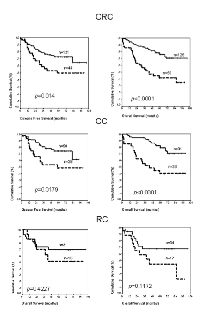
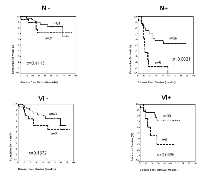
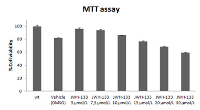
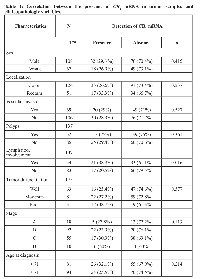
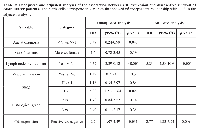
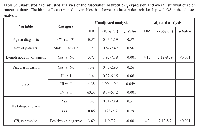
- 1. Inflammation and colon cancer. Gastroenterology. 2010;138:2101–2114 e5. https://doi.org/10.1053/j.gastro.2010.01.058. [PubMed].
- 2. Cannabinoids, endocannabinoids, and cancer. Cancer Metastasis Rev. 2011;30:599–612. https://doi.org/10.1007/s10555-011-9318-8. [PubMed].
- 3. Isolation and structure of a brain constituent that binds to the cannabinoid receptor. Science. 1992;258:1946–9. https://doi.org/10.1126/science.1470919. [PubMed].
- 4. Identification of an endogenous 2-monoglyceride, present in canine gut, that binds to cannabinoid receptors. Biochem Pharmacol. 1995;50:83–90. https://doi.org/10.1016/0006-2952(95)00109-d. [PubMed].
- 5. 2-Arachidonoylglycerol: a possible endogenous cannabinoid receptor ligand in brain. Biochem Biophys Res Commun. 1995;215:89–97. https://doi.org/10.1006/bbrc.1995.2437. [PubMed].
- 6. Structure of a cannabinoid receptor and functional expression of the cloned cDNA. Nature. 1990;346:561–4. https://doi.org/10.1038/346561a0. [PubMed].
- 7. Molecular characterization of a peripheral receptor for cannabinoids. Nature. 1993;365:61–5. https://doi.org/10.1038/365061a0. [PubMed].
- 8. Towards the use of cannabinoids as antitumour agents. Nat Rev Cancer. 2012;12:436–44. https://doi.org/10.1038/nrc3247. [PubMed].
- 9. Possible endocannabinoid control of colorectal cancer growth. Gastroenterology. 2003;125:677–87. https://doi.org/10.1016/s0016-5085(03)00881-3. [PubMed].
- 10. Loss of cannabinoid receptor 1 accelerates intestinal tumor growth. Cancer Res. 2008;68:6468–76. https://doi.org/10.1158/0008-5472.CAN-08-0896. [PubMed].
- 11. Cianchi F, Papucci L, Schiavone N, Lulli M, Magnelli L, Vinci MC, Messerini L, Manera C, Ronconi E, Romagnani P, Donnini M, Perigli G, Trallori G, Tanganelli E, Capaccioli S, Masini E. Cannabinoid receptor activation induces apoptosis through tumor necrosis factor alpha-mediated ceramide de novo synthesis in colon cancer cells. Clin Cancer Res. 2008;14:7691-700. https://doi.org/10.1158/1078-0432.CCR-08-0799. [PubMed].
- 12. Cannabinoids in intestinal inflammation and cancer. Pharmacol Res. 2009;60:117–25. https://doi.org/10.1016/j.phrs.2009.03.008. [PubMed].
- 13. Chemopreventive effect of the non-psychotropic phytocannabinoid cannabidiol on experimental colon cancer. J Mol Med. 2012;90:925–34. https://doi.org/10.1007/s00109-011-0856-x. [PubMed].
- 14. The endocannabinoid signaling system in cancer. Trends Pharmacol Sci. 2013;34:273–82. https://doi.org/10.1016/j.tips.2013.03.003. [PubMed].
- 15. Inhibition of glioma growth in vivo by selective activation of the CB(2) cannabinoid receptor. Cancer Res. 2001;61:5784–9. [PubMed].
- 16. A high cannabinoid CB(1) receptor immunoreactivity is associated with disease severity and outcome in prostate cancer. Eur J Cancer. 2009;45:174–82. https://doi.org/10.1016/j.ejca.2008.10.010. [PubMed].
- 17. Cannabinoids reduce ErbB2-driven breast cancer progression through Akt inhibition. Mol Cancer. 2010;9:196. https://doi.org/10.1186/1476-4598-9-196. [PubMed].
- 18. High tumour cannabinoid CB1 receptor immunoreactivity negatively impacts disease-specific survival in stage II microsatellite stable colorectal cancer. PLoS One. 2011;6:e23003. https://doi.org/10.1371/journal.pone.0023003. [PubMed].
- 19. Differential expression of cannabinoid receptors in the human colon: cannabinoids promote epithelial wound healing. Gastroenterology. 2005;129:437–53. https://doi.org/10.1016/j.gastro.2005.05.026. [PubMed].
- 20. E-cadherin and vitamin D receptor regulation by SNAIL and ZEB1 in colon cancer: clinicopathological correlations. Hum Mol Genet. 2005;14:3361–70. https://doi.org/10.1093/hmg/ddi366. [PubMed].
- 21. SNAI1 expression in colon cancer related with CDH1 and VDR downregulation in normal adjacent tissue. Oncogene. 2009;28:4375–85. https://doi.org/10.1038/onc.2009.285. [PubMed].
- 22. Greenhough A, Patsos HA, Williams AC, Paraskeva C. The cannabinoid delta(9)-tetrahydrocannabinol inhibits RAS-MAPK and PI3K-AKT survival signalling and induces BAD-mediated apoptosis in colorectal cancer cells. Int J Cancer. 2007;121:2172-80. https://doi.org/10.1002/ijc.22917. [PubMed].
- 23. Increased endocannabinoid levels reduce the development of precancerous lesions in the mouse colon. J Mol Med. 2008;86:89–98. https://doi.org/10.1007/s00109-007-0248-4. [PubMed].
- 24. The endogenous cannabinoid, anandamide, induces COX-2-dependent cell death in apoptosis-resistant colon cancer cells. Int J Oncol. 2010;37:187–93. https://doi.org/10.3892/ijo_00000666. [PubMed].
- 25. Cannabinoids and the gut: new developments and emerging concepts. Pharmacol Ther. 2010;126:21–38. https://doi.org/10.1016/j.pharmthera.2009.12.005. [PubMed].
- 26. Endocannabinoids and the regulation of their levels in health and disease. Curr Opin Lipidol. 2007;18:129–40. https://doi.org/10.1097/MOL.0b013e32803dbdec. [PubMed].
- 27. Cannabinoids induce cancer cell proliferation via tumor necrosis factor alpha-converting enzyme (TACE/ADAM17)-mediated transactivation of the epidermal growth factor receptor. Cancer Res. 2004;64:1943–50. https://doi.org/10.1158/0008-5472.can-03-3720. [PubMed].
- 28. Transitions between epithelial and mesenchymal states: acquisition of malignant and stem cell traits. Nat Rev Cancer. 2009;9:265–73. https://doi.org/10.1038/nrc2620. [PubMed].
- 29. Prognostic and predictive significance of proliferation in 867 colorectal cancers. J Clin Pathol. 2012;65:989–95. https://doi.org/10.1136/jclinpath-2012-200911. [PubMed].
Last Modified: 2016-06-11 06:14:55 EDT
